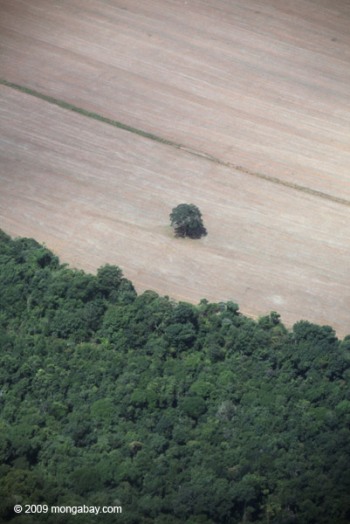Brazil, the US, and China have biggest overall environmental impact.
Developing countries are not the only ones that could benefit from a little environmental support. Wealthier countries may need to ‘know themselves’ and address these issues at home too. According to a recent study in the open access journal PLoS ONE, wealth may be the most important factor determining a country’s environmental impact.
The team had originally planned to study “country-level environmental performance and human health issues,” lead author Corey Bradshaw, Director of Ecological Modeling and professor at the University of Adelaide, told mongabay.com. Once they began looking at the available indexes, however, they saw the need for a purely environmental analysis.
The analysis ranked countries based on natural forest loss, natural habitat conversion, marine captures, fertilizer use, water pollution, carbon emissions, and biodiversity threat. The resulting index compares countries based on their overall impact (absolute environmental impact) and their impact relative to available resources (proportional impact). This index focuses solely on environmental impact and does not attempt to incorporate external factors such as human health indicators, happiness, or economic strength into the calculations.
 Lone Brazil nut tree in deforested area in Brazil. According to a new environmental index, of the world’s nations Brazil has the greatest environment impact. Deforestation was one of the factors included in the index’s findings. Photo by: Rhett A. Butler. |
The populous and environmentally influential countries are generally the most harmful environmentally, the analysis found.
“Basically, the richer a country becomes the more damage it tends to do, both absolutely and relative to opportunity,” says Bradshaw.
Brazil, the US, and China (in that order) soared to the top three spots in the list of countries with the highest overall impact.
Bradshaw explained that this mostly results from the size of the economy and population: “these large economies consume the most resources and are the greatest overall polluters.”
Though population and governance quality are both integral factors in a country’s ecological behaviors, this analysis suggests that the main factor is wealth.
These findings run counter to the ‘environmental Kuznet’s curve hypothesis’, which basically states that a developing country will go through a time of intense environmental damage until it reaches a certain level of development. When “some wealth threshold is surpassed, countries should begin to reduce their impact given access to cleaner technologies, a more educated middle class and a higher environmental conscience,” explained Bradshaw.
But the team “found no evidence for an improvement in environmental performance in the richest of countries.”
When asked to comment on the environmental Kuznet’s curve hypothesis in light of this index, Bradshaw stated, “It’s an attractive idea because it basically justifies uncapped economic growth. The sad reality is that our currently economic model…encourages runaway consumption rather than environmental stewardship. In my view, the hypothesis has no support at the global scale.”
The ‘Top Twenty’ worst ranked countries for overall environmental impact were: Brazil, USA, China, Indonesia, Japan, Mexico, India, Russia, Australia, Peru, Argentina, Canada, Malaysia, Myanmar, Ukraine, Thailand, Philippines, France, South Africa, and Colombia.
France is the only European country that appears in the ‘Top Twenty’ listed above. Unfortunately, it does not necessarily follow that European countries have found a way to put their wealth to work for the environment.
According to Bradshaw, population is one factor that pushes European countries off the list. France is one of Europe’s largest countries and economies. Other European countries have proportionally high environmental impacts, but sidle off the ‘Top Twenty’ to make room for more populous countries.
Bradshaw also pointed out that developing countries are at a disadvantage in indexes (like this one) that rely on recent data.
 Urban Singapore: men in yellow clean the exterior of the Esplanade (Theatres by the Bay). According to the environmental index, Singapore has the greatest proportional environmental impact. Photo by: Rhett A. Butler. |
“The data covered mainly the last 30 years or so, so it necessarily penalizes countries that have done most of their developing during the last half century.”
The team had predicted that large, wealthy countries would perform poorly, but they were surprised by the results once they began their analysis. “…Once we had corrected for a country’s resource base opportunity, the ranking took some unexpected turns. We certainly didn’t expect Asian countries would perform so badly…”
Though the index provides a fairly clear picture of global environmental practices, it could not account for ‘overflow’—when one country exploits the environmental resources of another through economic exchange.
Governance quality is also correlated with environmental practices, but this is a weaker correlation that is easily overruled by population or wealth.
Indexes like this one can help the global community identify role model countries and point out problem nations.
Though some countries were excluded based on insufficient data, “the data coverage was actually pretty good,” says Bradshaw. “We managed to include most countries…and the ones that were missing were generally small island nations with small global footprints.”
Despite findings that run directly counter to the environmental Kuznet’s curve hypothesis, the general public has been receiving the index fairly well. Though Dr. Bradshaw mentioned some resistance from the uninformed, “most responses have been positive, or at least, acknowledging of the problem.”
For more information on Corey Bradshaw’s work and other conservation news check out his blog: Conservation Bytes.
Related articles
World failing on every environmental issue: an op-ed for Earth Day

(04/22/2010) The biodiversity crisis, the climate crisis, the deforestation crisis: we are living in an age when environmental issues have moved from regional problems to global ones. A generation or two before ours and one might speak of saving the beauty of Northern California; conserving a single species—say the white rhino—from extinction; or preserving an ecological region like the Amazon. That was a different age. Today we speak of preserving world biodiversity, of saving the ‘lungs of the planet’, of mitigating global climate change. No longer are humans over-reaching in just one region, but we are overreaching the whole planet, stretching ecological systems to a breaking point. While we are aware of the issues that threaten the well-being of life on this planet, including our own, how are we progressing on solutions?
Collapsing biodiversity is a ‘wake-up call for humanity’
(05/10/2010) A joint report released today by the Convention on Biological Diversity (CBD) and the UN Environment Program (UNEP) finds that our natural support systems are on the verge of collapsing unless radical changes are made to preserve the world’s biodiversity. Executive Secretary of the Convention on Biological Diversity, Ahmed Djoghlaf, called the bleak report “a wake-up call for humanity.”
What happened to China?: the nation’s environmental woes and its future

(04/01/2010) China has long been an example of what not to do to achieve environmentally sustainability. Ranking 133rd out of 146 countries in 2005 for environmental performance, China faces major environmental problems including severe air and water pollution, deforestation, water-issues, desertification, extinction, and overpopulation. A new article in Science discusses the complex issues that have led to China’s environmental woes, and where the nation can go to from here.
Consumption habits cause rich countries to outsource emissions
(03/08/2010) Over a third of the greenhouse gas emissions related to the consumption of goods in wealthy nations actually occur in developing countries, according to a new analysis by researchers with the Carnegie Institution. Annually, each person if the United States outsources 2.5 tons of carbon due to consumption habits, most frequently in China. In Europe the figure of ‘outsourced’ emissions rises to 4 tons per person.
Will it be possible to feed nine billion people sustainably?

(01/28/2010) Sometime around 2050 researchers estimate that the global population will level-out at nine billion people, adding over two billion more people to the planet. Since, one billion of the world’s population (more than one in seven) are currently going hungry—the largest number in all of history—scientists are struggling with how, not only to feed those who are hungry today, but also the additional two billion that will soon grace our planet. In a new paper in Science researchers make recommendations on how the world may one day feed nine billion people—sustainably.